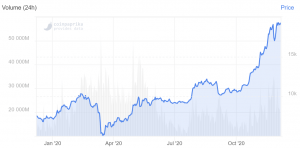
2020 was the year that the bitcoin (BTC) and the wider crypto market started responding to macroeconomic trends and indicators more actively. While critics continue to argue that this market responds only to its own issues and movements, it looks like investment in bitcoin from the likes of MicroStrategy, Square, and even SMEs like Snappa and Tahini’s was a reaction to low interest rates and a struggling dollar.
USD/EUR rate

This is likely to continue into 2021, with a range of industry figures and analysts telling Cryptonews.com that they expect low interest rates and quantitative easing (QE) to remain fixtures of the macroeconomic landscape for some time to come. And while some expect deflation to be more of a risk in the first half of the year, others expect inflation or currency debasement to be a possibility in the second half.
Taken together, this all suggests that 2021 might be favorable for cryptoassets — and bitcoin in particular — in terms of the macroeconomic climate.
2020: What did experts say?
Back in 2019, experts predicted that 2020 would bring low interest rates. They also suggested that the year may witness a global recession, which a growing number of economists were forecasting at the time.
With the help of the coronavirus pandemic, these two predictions have been proven true, with the decline of (already low) interest rates and a global recession helping to boost bitcoin and other cryptoassets, even if the crypto market suffered something like a massive flash crash in March when the pandemic first rocked global markets.
Experts also suggested that ongoing trade conflicts and difficulties may increase investor demand for ‘safe’ assets such as bitcoin. However, international trade has been overshadowed by the response to COVID-19, so it’s hard to say whether the ongoing risk of a no-deal Brexit, for example, contributed to the crypto market’s 207% rise in capitalization this year.
Hot money printers and low interest rates
Everyone we’ve spoken to estimate that quantitative easing and — in particular — low interest rates will continue in 2021 (and possibly beyond).
“Rates are likely to stay low for the foreseeable future because much of the developed world simply can’t handle higher interest rates,” said Kevin Kelly, the co-founder and chartered financial analyst at Delphi Digital.
According to him, higher interest rates would cause financial conditions to tighten, which would drive up default rates and bankruptcies at a time when optimistic growth prospects are already hard to come by.
Kelly added that large-scale debt monetization (aka QE) is likely to continue well into 2021, particularly as governments issue more sovereign debt to finance the spending required to keep the global economy afloat. And he isn’t the only one who estimates this, with Bitcoin developer, educator and entrepreneur Jimmy Song suggesting that politicians are more or less politically obliged to keep the dollar printer going.
“Quantitative easing is the only way any of these politicians will get to get any support, so that's what they'll do. 2021 might not be as crazy in terms of money printing, but the effects of USD expansion should be felt around the world as this newly printed money circulates,” he told Cryptonews.com.
There’s now an emerging school of thought that the arrival of effective coronavirus vaccines will help the global economy get out of its funk in 2021. However, Bloomberg Intelligence senior commodity strategist Mike McGlone is more cautious.
“I have no clue how long it will last, but expect the trends to be enduring and think there is a bit too much optimism that widely distributed vaccines will reverse rapidly rising Debt-to-GDP, QE and MMT on a global basis,” he said.
Deflation, inflation, and devaluation
The continuation of quantitative easing raises the specter of inflation, although experts think deflation will be more of a problem for much of 2021, given the stagnating global economy.
“Deflation remains the predominant trend, notably on the back of paradigm shifts in rapidly advancing technology and demographics (aging populations). Primary indicators are the price of WTI crude oil and natural gas, both down about 70%+ since the financial crisis,” said Mike McGlone.
That said, inflation may surface in 2021 in a particular form, as currency debasement.
“I expect inflation will eventually resurface, but is more likely to be currency-debasement type and may take the opposite of what squashed inflation in the 1980's — high rates then vs. negative rates in the US following Japan and much of Europe, which may be a stock bear-market away,” the strategist said.
This is a view shared by Lyn Alden, an analyst and founder of Lyn Alden Investment Strategy, and Swan Bitcoin, a BTC investing app, advisor.
“Many developed markets are purposely attempting to weaken their currencies vs other currencies, so that their exports remain competitive on the global scene,” she said.
Alden also told Cryptonews.com that she expects inflation to arrive towards the end of the year, as deficits expand and governments are forced to create even more money to finance them.
“By late 2021, I wouldn't be surprised to see an uptick in inflation, and it could depend in part on commodity prices, like if OPEC keeps oil supply tight and oil demand comes back by the end of 2021,” she added.
Likewise, Jimmy Song expects inflation to be a problem for smaller economies, with USD remaining relatively insulated from the effects of monetary expansion.
“USD is very liquid, whereas the Turkish Lira, for example is not. The less liquid currencies will suffer much more from inflation as people will naturally go toward the more liquid currency. USD will suffer a bit, but only after the third world countries suffer,” he said.
'A pivotal moment'
Taken with extremely low interest rates, the effects of increasing inflation and currency devaluation will make bitcoin and other cryptoassets seem more attractive to the average investor.
“I expect bitcoin to continue advancing in price and it may be similar to the jump in 2017, which was over 1,000%,” said Mike McGlone. “The rest of the crypto market, which is oversupplied will likely follow bitcoin, but underperform.”
McGlone added that 2021 may be “almost a perfect storm” for bitcoin.
“The macroeconomic conditions are notably favorable — Bitcoin has the foundation of a sharp correction and period of disdain, unprecedented QE on a global basis in the year following a cut in supply (halving), with institutions getting in and entities like PayPal bringing exposure to the masses,” he added.
BTC/USD price chart

That said, if the global economy faces another shock (rather than subdued rates and ongoing QE), this may reduce investor appetite for more speculative assets, such as crypto.
“If economic conditions worsen, we could see BTC and crypto assets suffer if market volatility blows out again or if risk-off sentiment turns extreme,” said Kevin Kelly.
This scenario seems to be less likely, given the appearance of seemingly effective coronavirus vaccines (although who knows what surprises 2021 may bring). Instead, the overriding macroeconomic conditions might push investors towards bitcoin, given that other ways of turning a profit with capital will remain few and far between.
For Henri Arslanian, Global Crypto Leader at PwC, this all means that 2021 could be a key year for crypto.
He said,
“I truly believe that the period we are going through right now will be seen as a pivotal moment in the history of money where developments like record levels of quantitative easing and financial stimuli intercept with record levels of interest in bitcoin and central bank digital currencies.”
___
Learn more:
Crypto Adoption in 2021: Bitcoin Rules, Ethereum Grows & Faces Rivals
Crypto Regulation in 2021: The Piecemeal Approach & New Winds
Crypto in 2021: Institutions Prefer Bitcoin, Retail Open to Altcoins
Crypto Tech In 2021: Focus on Scalability, Privacy and Usability
Crypto Security in 2021: More Threats Against DeFi and Individual Users














